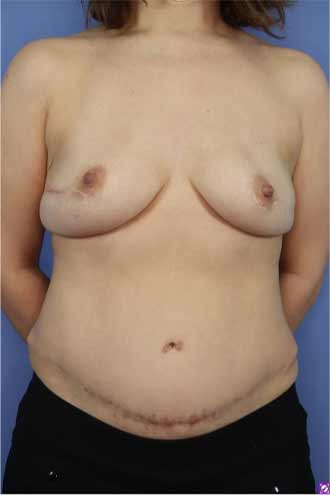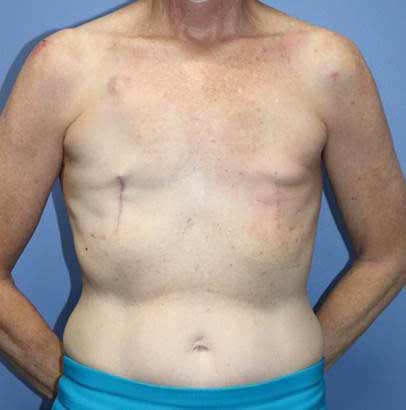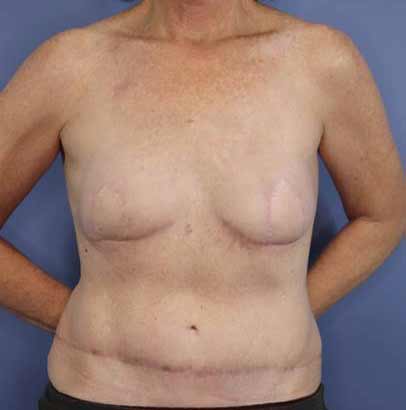Recovery From DIEP
Conveniently located to serve the areas of Lake Forest and Chicago, IL

Recovery after a DIEP flap surgical procedure is a 6-8 week-long period during which patients will start to heal from the physical and mental challenges of breast reconstruction. The procedure’s name derives from a primary blood vessel in the body, the branches of which are moved during this procedure; the deep inferior epigastric perforator (DIEP). Sensitive to the needs and vulnerabilities of our patients after their mastectomy, we provide DIEP surgery to help women regain body confidence and self-esteem after what we know can feel like a monumental step into the unknown.
For confidential treatment at your discretion, look no further than Dr. Michael Howard for your post-mastectomy reconstructive breast surgery. Serving Lake Forest and the greater Chicago area, MH Plastic Surgery is committed to providing world-class treatment to patients. To schedule a consultation with Dr. Howard, please call (224) 271-4250 and speak to our friendly, knowledgeable staff or fill out one of our contact forms on our website.
Contents
Before and After Photos
What is Autologous Breast Reconstruction?
An autologous DIEP procedure is a reconstructive surgery that uses a woman’s own tissue to form a new breast shape following a mastectomy. In autologous procedures, surgeons use living tissue from other areas of the body to form breast shape rather than using implants as a means for reconstruction.
Where is The DIEP Artery and What Does It Do?
The deep inferior epigastric perforator is a blood vessel in the lower body. It arises from the external iliac artery and runs under the rectus muscle. It is one of the major blood vessels that supplies the anterior abdominal wall.(1) The venous structures of the DIEP are carefully repositioned during a DIEP flap procedure to provide living tissue for breast reconstruction.
Compassionate Care for Every Patient
The impact of breast cancer and its treatment methods on patients include adverse effects on mental health and changes in body esteem.(2) A mastectomy is an often necessary but rarely straightforward surgery for breast cancer patients, and it comes with its own difficulties. The postoperative aesthetics of chest scarring, as well as the overall experience of undergoing cancer treatment can be a source of physical discomfort and mental anguish for many women, which is why Dr. Howard will do everything he can to make the process as straightforward and comfortable as possible.
Comparing DIEP Recovery to Implant Recovery

Choosing the right reconstructive surgery after a mastectomy is a deeply personal decision. With expert guidance from experienced medical professionals such as Dr. Howard, you can make an informed choice for your body and undergo a breast reconstruction that will yield the most satisfying results. Clinical studies have shown that patients who underwent reconstruction using perforator flaps have higher overall satisfaction with their results compared to those who underwent different reconstruction methods.(3)
The DIEP flap technique is known as a procedure that limits surgical impact on muscle, which can mean shorter recovery time. In addition, it has many more advantages over implants, including:
- Use of the body’s own natural tissue, with no additional foreign material inserted.
- Warm, soft feel to reconstructed breasts, unlike some implant reconstructions.
- Long-lasting reconstruction results (implants may need replacing 10-15 years after initial surgery).
- Minimal muscle trauma which can minimize pain and maintain abdominal muscle strength after surgery.
Your personal perception of your body is a crucial factor when deciding which reconstructive pathway to take. With DIEP reconstruction, the results are more natural-looking and natural-feeling. In the same clinical study, 91% of the DIEP patients saw their reconstructed breast as a natural part of their own body, whereas only 40% of patients who underwent prosthetic reconstruction stated the same.(3)
For professional medical guidance in challenging times, trust Dr. Howard to provide your care. Speak to our Lake Forest office by calling (224) 271-4250 or visit our website to fill out an inquiry form about breast reconstructive surgery.
TRAM vs. DIEP: Which is Better?
There are two main autologous surgery techniques that can be used in breast reconstruction:
TRAM Flap Surgery
Although it is a similar procedure, the transverse rectus abdominis (TRAM) flap procedure includes the removal of a significant amount of abdominal muscle tissue, which could potentially cause core muscle weakness.
DIEP Flap Surgery
Although TRAM procedures are still performed by surgeons today, DIEP flap surgeries provide a surgical option that greatly reduces the risk of abdominal muscle weakness. The DIEP breast reconstruction technique uses the same excess skin and fat as the TRAM procedure but preserves the delicate abdominal muscles and abdominal wall fascia.
Choosing the right cosmetic surgery for your individual needs can be daunting. With a wealth of expertise in the field, Dr. Howard will provide you with professional, compassionate advice throughout your breast reconstruction journey.
Meet our team of helpful staff and start your healing journey with us today!
Recovery & Results of DIEP Breast Reconstruction

Studies have shown that the favorable aesthetic results of DIEP flap breast reconstruction have a beneficial effect on patients’ self-esteem.(4) However, it is important to have realistic expectations for your DIEP breast reconstruction. Every woman’s body is different, and no two mastectomy results are the same. Your breasts will maintain an optimal, natural look from the DIEP flap procedure, but they may not look or feel exactly the same as they did before your mastectomy. Your autologous breast reduction surgery may help you to:
- Create fuller breast contour and shape.
- Help your breasts look natural under clothing .
- Forgo the use of an external prosthesis in your bra after your mastectomy.
A DIEP flap breast reconstruction surgery with Dr. Howard may help to significantly improve your self-esteem and body image, but please bear in mind that the way you approach your recovery is the key to safe, effective healing.
Northwestern Enhanced DIEP Recovery Pathway
Postoperative studies in women who underwent mastectomy procedures have shown that an enhanced clinical care pathway successfully promotes early recovery. (4) With Northwestern Medicine’s enhanced recovery program (ERP) pathway, patients can feel at ease knowing that their recovery process will be safe, and speedy. This program provides extensive pre- and post-operative information and advice to patients recovering from a DIEP procedure.
After your surgery, you will wake up in the Post-anesthesia Care Unit (PACU). You may stay for several hours while our nurses monitor your recovery process. You may have an oxygen mask over your face or tubing by your nose and an IV in your vein giving you fluids and medicine.(5)
The Northwestern ERP will also include an extensive recovery timeline which includes the following things.
- Detailed post-surgery guidance for the day of your surgery
- Wound care advice
- Approved activities during recovery
- How to manage postoperative pain
- Doctor contact information for follow-up care(5)
With breast reconstructive surgery, realistic expectations, patience and trust in the process are key factors in the recovery process. As with any abdominal surgery, you should expect some transient abdominal pain. It is essential that you allow yourself the time to heal and create a safe, accessible recovery environment at home. Here at our Chicago, Lake Forest, and Glenview offices, we want to help support you as you face the challenges of life as a cancer survivor with confidence, defiance, and grace. For more information, get in touch with Dr. Howard’s friendly staff, who can outline the benefits of an expedited recovery plan after a DIEP flap breast reconstruction procedure.
Cost of a DIEP Procedure in Chicago, IL
Although many breast and body procedures are classified as elective and not covered by insurance, patients who have undergone a mastectomy will be relieved to discover that breast reconstruction is covered by most health insurance plans. In 1998, the Women’s Health and Cancer Rights Act was passed in the US to support mandatory insurance coverage for breast reconstruction surgery.(6) This means if your insurance covers mastectomy, then by law it must cover post-mastectomy reconstruction of breast tissue. For more information about the cost of your cosmetic surgery, you can complete an inquiry form via our website.
FAQ
Does DIEP flap surgery use implants?
No, implants are not used in DIEP flap surgery. In a DIEP flap surgery procedure, skin and fatty tissues are taken from the patient’s abdomen, reshaped, and repositioned on the chest to form a natural-looking breast shape.
How long do breast implants last?
Although many women opt for implants to increase or augment their breasts, they are certainly not permanent. Modern breast implants are designed to last up to ten years. As an alternative to implants, women recovering from mastectomy surgery may benefit from non-implant breast reconstruction such as DIEP flap breast reconstruction, in which surgeons use the patient’s own skin and tissue to form a new breast shape.
Is it better to have a DIEP flap procedure or implants after a mastectomy?
Every woman’s personal circumstances are different after a mastectomy, so, on the advice of medical professionals, choosing the right reconstructive surgery is at the discretion of the individual. Speak to a board-certified cosmetic surgeon to discuss your breast reconstruction goals.
References
- Mustafa, A. Y. A. A., Alasmari, W. A., Mustafa, A. Y. A. A., & Alasmari, W. A. (2021). Anatomical Study and Clinical Importance of the Inferior Epigastric Artery. International Journal of Morphology, 39(3), 688–691. https://doi.org/10.4067/S0717-95022021000300688
- Ghodusi, M., & Heidari, M. (2015). The relationship between body esteem and hope and mental health in breast cancer patients after mastectomy. Indian Journal of Palliative Care, 21(2), 198. https://doi.org/10.4103/0973-1075.156500
- Sgarzani, R., Negosanti, L., Morselli, P. G., Vietti Michelina, V., Lapalorcia, L. M., & Cipriani, R. (2015b). Patient Satisfaction and Quality of Life in DIEAP Flap versus Implant Breast Reconstruction. Surgery Research and Practice, 2015, 405163. https://doi.org/10.1155/2015/405163
- Astanehe, A., Temple-Oberle, C., Nielsen, M., de Haas, W., Lindsay, R., Matthews, J., … Schrag, C. (2018). An Enhanced Recovery after Surgery Pathway for Microvascular Breast Reconstruction Is Safe and Effective. Plastic and Reconstructive Surgery – Global Open, 6(1), e1634. https://doi.org/10.1097/gox.0000000000001634
- Enhanced Recovery Pathway for Breast Surgery. (n.d.). Retrieved from https://www.nm.org/-/media/northwestern/resources/patients-and-visitors/patient-education-about-your-surgery/northwestern-medicine-breast-surgery-enhanced-recovery-pathway.pdf
- Maass, S. W. M. C., Bagher, S., Hofer, S. O. P., Baxter, N. N., & Zhong, T. (2015). Systematic Review: Aesthetic Assessment of Breast Reconstruction Outcomes by Healthcare Professionals. Annals of Surgical Oncology, 22(13), 4305–4316. https://doi.org/10.1245/s10434-015-4434-2
- Women’s Health and Cancer Rights Act (WHCRA) | CMS. (2013). Retrieved from Cms.gov website: https://www.cms.gov/CCIIO/Programs-and-Initiatives/Other-Insurance-Protections/whcra_factsheet








